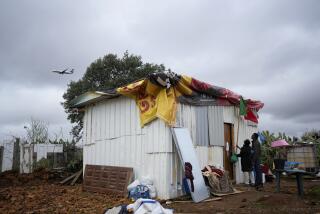Strapped Young Farmers Switching From Grains to More Exotic Crops in Portugal
- Share via
TORRES NOVAS, Portugal — Young Portuguese farmers are looking for more stable incomes by switching from traditional grains such as wheat and corn to more exotic crops such as pistachio nuts and truffles.
Among the hundreds of visitors in October to the Third National Dry Fruits Fair in this rural town 73 miles northeast of Lisbon, those most interested in new crops seemed to be young farmers.
One such couple--38-year-old former airline steward Jose Eduardo Carvalho and his American wife, Paula, 25--said they are switching from wheat to pistachios, almonds, walnuts, papaya and truffles on the 207-acre farm that he inherited from his parents in the Alentejo region north of the Tagus River.
Lost $26,000 on Wheat
The couple said the farm lost more than $26,000 last year on wheat.
“We’ve both traveled widely, and wherever we went pistachios were so expensive that Jose decided it was time to try grow them himself,” said Paula, a New Jersey native.
Carvalho said he hopes to tap the European Economic Communities (EEC) market, which Portugal’s Institute for Foreign Trade said imported 61,480 tons of almonds and 38,557 tons of pistachios last year.
The institute’s data also shows that Portugal’s exports of almonds to the United States have been steadily increasing, reaching 14,000 tons in 1986 and 18,100 tons in 1987.
But converting his father’s crops to more profitable nuts and fruit is not going to be cheap.
Carvalho said he has already spent $35,000 to import irrigation equipment from neighboring Spain.
But the Carvalhos, as young farmers in Western Europe’s poorest nation, are eligible for EEC aid to help them pay for new projects.
Other farmers are not so fortunate.
About two-thirds of Portugal’s estimated 970,000 farmers, who make up about one-fifth of the country’s working population but contribute only about 9% to the country’s gross domestic product, are over 55 years old and thus do not qualify for such assistance projects.
Many of the farmers in isolated rural areas also have the added burden of illiteracy and are less motivated to innovate.
Low Productivity
Their productivity lags way behind the West European average, and Portugal has to import more than half of what its population of 10 million eats.
“Portugal has to select the most appropriate products it can grow for current market demands,” said Manuel Rosa, a service director at the Ministry of Agriculture.
This factor means that the production of grains (wheat, corn, rye, barley and oats) has to be cut back and more oranges, lemons and grapefruit planted. Although citrus crops compete directly with those of other Mediterranean countries, they still find a market in the colder, northern European countries.
Other new hopefuls are strawberries and melons. Small-scale production of avocados by farmers in the southern Algarve region increased from 353 tons in 1980 to more than 870 tons in 1986, according to the foreign-trade institute.
“Portugal’s climate is such that it can grow practically anything exotic,” said Carvalho, whose decision to cultivate truffles was prompted by a look at market prices abroad.
London’s famous specialist grocer, Fortnum & Mason, sells 50 grams (1.6 ounces) of imported white Italian truffles for the equivalent of $83--or about $725 a pound.
French truffles at Fortnum’s run more than $900 a pound.
More to Read
Sign up for Essential California
The most important California stories and recommendations in your inbox every morning.
You may occasionally receive promotional content from the Los Angeles Times.













